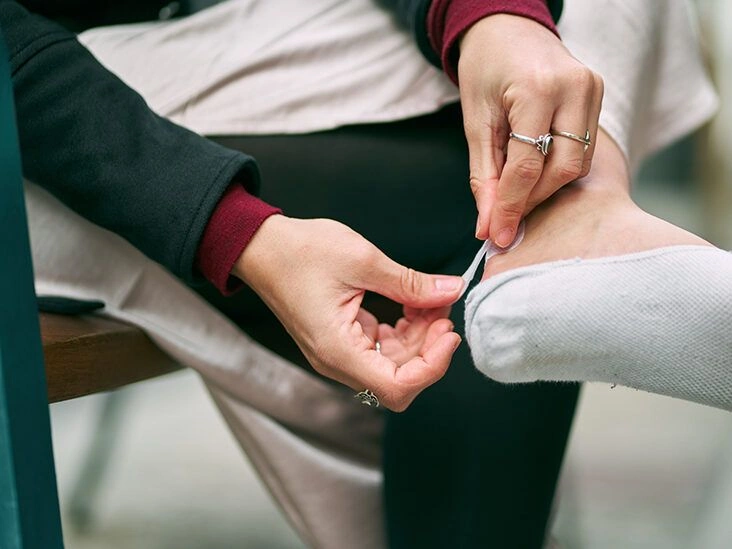Certain everyday habits, such as wearing shoes that are too tight, can lead to blisters. But blisters can also arise from medical issues like burns and infections, including chickenpox, shingles, and impetigo.
Blisters (vesicles) are raised sections of skin filled with fluid.
They most commonly develop from repeated friction between the skin and an abrasive surface. For example, tight footwear can produce a blister on your heel, or gardening without gloves can cause one on your palm.
Although they can be bothersome and painful, most blisters will resolve on their own within 1 week.
Still, unexplained or persistent blistering could indicate an underlying medical issue that should be assessed by a physician for potential treatment.
Below are 13 other potential causes of blister formation.
1. Herpes simplex
The herpes simplex virus produces painful blisters that may occur singly or in clusters, leak clear or yellowish fluid, and then crust over.
On the lips and around the mouth, it’s known as a cold sore, most commonly due to HSV-1 but occasionally from HSV-2.
When it affects the genital area, it’s called genital herpes—typically an STI caused by HSV-2, though HSV-1 can also cause genital infections.
Recurrences may be provoked by stress, menstruation, illness, or sun exposure. The affected site often itches or tingles before blisters form.
2. Impetigo
Impetigo is a frequent bacterial skin infection in infants and young children. It produces an irritating rash and fluid-filled blisters that rupture easily and leave a honey-colored crust.
The rash often appears around the mouth, chin, and nose.

4. Contact dermatitis

Contact dermatitis occurs when skin becomes itchy, discolored, scaly, or raw after touching an irritant or allergen. Blisters may also develop, which can ooze, weep, or become crusted.
Symptoms typically appear after the skin has been exposed to the triggering substance.
Common irritants include poison ivy, poison oak, certain laundry detergents, nickel, and some textiles.
»Learn more:What causes contact dermatitis?5. Aphthous stomatitis

Aphthous stomatitis, commonly called a canker sore, can be triggered by infection, trauma, stress, or other illnesses.
These mouth lesions are round or oval with a red, inflamed margin and a yellow or white center.
While they may resemble blisters, canker sores are shallow ulcers rather than true fluid-filled blisters.
6. Frostbite

Frostbite results from extreme cold and can affect fingers, toes, nose, ears, cheeks, or the chin.
Symptoms include numbness and color changes in the skin, and in more severe cases, blisters filled with clear fluid or blood.
Mild frostbite sometimes needs urgent care. Severe frostbite or any signs of hypothermia require emergency medical attention.
7. Shingles

Shingles is caused by the varicella-zoster virus, the same virus responsible for chickenpox.
It produces a very painful rash of fluid-filled blisters that typically appear in a linear stripe on one side of the body. The rash is often accompanied by low fever, chills, headache, or fatigue.
8. Chickenpox

Chickenpox produces clusters of itchy, discolored, fluid-filled blisters in various stages of healing across the body.
The rash is often accompanied by fever, body aches, sore throat, and reduced appetite. Chickenpox is contagious until all blisters have crusted.
A varicella vaccine is available to help reduce the risk of chickenpox and later shingles.
9. Dyshidrotic eczema

Dyshidrotic eczema causes itchy blisters, most commonly on the hands, fingers, or feet.
The exact cause is uncertain, but it may be linked to allergic reactions. Symptoms include dry, discolored, scaly skin and deep fissures.
10. Pemphigoid

Pemphigoid is an uncommon autoimmune disorder that produces a rash and blisters on different body areas.
There are several forms of pemphigoid, which may affect distinct regions of the body:
- Bullous pemphigoid (BP): Blisters typically involve the skin and may show up on the abdomen, groin, or inside joints like knees and elbows.
- Mucous membrane pemphigoid (MMPG): Usually affects mucous membranes of the eyes and mouth, as well as the genitals, throat, and nose.
A discolored rash often precedes blister formation. Later, large, tense blisters develop containing clear fluid or blood, and ruptured blisters are usually painful.
11. Pemphigus vulgaris

Pemphigus vulgaris is a rare autoimmune disorder that affects the skin and mucous membranes of areas such as the face, genitals, throat, and windpipe.
It leads to painful, itchy blisters that break and bleed easily, and can make eating or swallowing painful.
12. Erysipelas

Erysipelas is a bacterial infection of the upper layers of the skin.
It’s commonly caused by group A Streptococcus bacteria (GAS). Symptoms may include fever, chills, skin swelling, and blisters in the infected area.
13. Dermatitis herpetiformis

Dermatitis herpetiformis is an intensely itchy, blistering rash that is associated with celiac disease.
It features extremely itchy bumps containing clear fluid that appear and resolve in cycles of waxing and waning.
When to see a doctor
Most blisters don’t need medical treatment and will typically clear up within 1 week if left alone.
Seek medical advice if:
- a blister hasn’t improved after 1 week
- the blister is painful, warm, or contains blood or discolored pus
- the skin surrounding the blister is swollen or discolored
- blisters appear without an obvious cause
A clinician can assess your symptoms, review your medical history, and establish an accurate diagnosis and treatment plan.
Treatment varies with the cause and may include oral antibiotics or topical therapies such as steroid creams.
Do not deliberately puncture a blister, as the skin covering the fluid helps protect against infection. If your blisters are caused by a contagious infection like shingles, consider covering active lesions.
The bottom line
Blisters are raised pockets of skin filled with fluid.
In many instances, they’re produced by friction from objects like tight footwear. Yet various medical conditions — including eczema, chickenpox, shingles, and burns — can also cause blisters.
Consult a healthcare provider if you have a single or clustered blister that doesn’t improve or appears without a clear reason. They can determine the cause and recommend appropriate treatment.


















Leave a Reply
You must be logged in to post a comment.